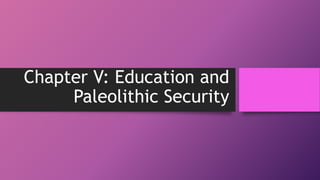
Chapter 5 product
- 1. Chapter V: Education and Paleolithic Security
- 2. Main Characters • The Clever Fisherman- He realized he could catch more fish with more area and proposed a bargain with a slow fisherman. He was the first one to think of private ownership of parts of the creek. • The Slow Fisherman- He was easily persuaded by the clever fisherman because he was confused by the math and thought he was getting a good deal. • The Great Fish Chiefs- These three men did all of the fish catching for the tribe and hired help when they had such a surplus that they could not operate their nets and smoke all the fish.
- 3. Main Characters • The Main Chiefs- Convinced the fish chiefs to turn their profit over to them so that they could distribute the excess to the unemployed. • The Demented Tribesman- He saw the problems with the economic system and suggested everyone go back to catching their own fish and antelope and setting their own bear traps. • The Inquiring Teacher- He thought that the teachers should teach the tribe how to come up with a better system, but his ideas were shot down by the other teachers.
- 4. Main Ideas The clever fisherman offered the slow fisherman 5 fish a day if he could take over the slow fisherman’s hole in the creek. He was successful and started taking over more people’s creek holes. Other clever fishermen started doing the same until only three great fish chiefs caught all of the fish for the tribe. There was too much work for the chiefs to do so they hired unemployed tribesman to tend to the nets and smoke fish for them for the price of 2 fish a day. They soon hired women and children too. Eventually, there was a huge surplus of fish that the chiefs could not get rid of. The main chiefs offered exclusive rights to any fisherman who “would give the whole tribe a pile of fish as high as a man (pg. 104).” The gave one half-fish to the unemployed man and a quarter-fish to unemployed women and children.
- 5. Main Ideas The fish chiefs had entire control over the industry and soon the antelope and bear chiefs followed in the same path. More and more people became unemployed and they depended on the main chiefs (aka the government) to supply them with fish, meat, and skins. The main chiefs piles soon grew so large they could not find any use for them and the piles began to rot. Everyone except the fish, antelope, and bear chiefs were unemployed and hungry. The chiefs decided to tax the fish, antelope, and bear chiefs so that they could once again provide for the needy. A demented tribesman thought this economic system was unfair and suggested everyone go back to catching their own fish and antelope and trapping their own bears. He was “ducked” in the creek for his radical thoughts until he promised to agree with the current system. A teacher who witnessed the “ducking” suggested he and the other teachers educate the people on how to devise a better system where no one would starve. His peers warned him talking like that would get him fired, so he kept his ideas to himself. He was eventually fired because the economy was so bad that the schools had to fire half their staff.
- 6. Historical Context • The main chiefs taking the surplus of food and rationing it out to the poor reminded me of the breadlines and soup kitchens present after the Great Depression. Although the soup kitchens provided this food for free, often it was not enough to feed a family and many people went hungry. In a similar manner, the main chiefs would only give a half-fish to an unemployed man and a quarter- fish for women and children. This means a family of 5 who used to eat 5 fish a day now only got one and one half-fish. • I am also reminded of the US welfare system. Much like the soup kitchens of the Great Depression (and the fish piles of the tribe) they provide for the poor but often it is not enough.
- 7. Connection to Modern Education Although there is not much mention of education in this chapter, I do see a resemblance of the inquisitive teacher, as well as the demented tribesman, to the ideas that led to unions. When individuals see that something (usually a form of government) is unfair they voice their opinions and form unions with those who are like minded to them. Although teacher unions are meant to protect teachers in the classroom, some (like Raymond Wayne) argue that they do the educational system more harm than good.